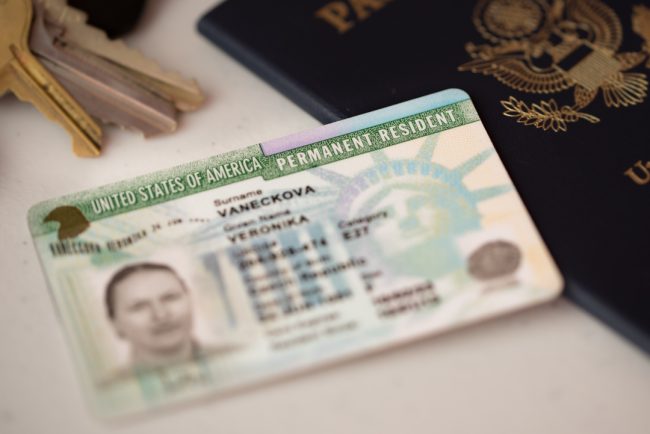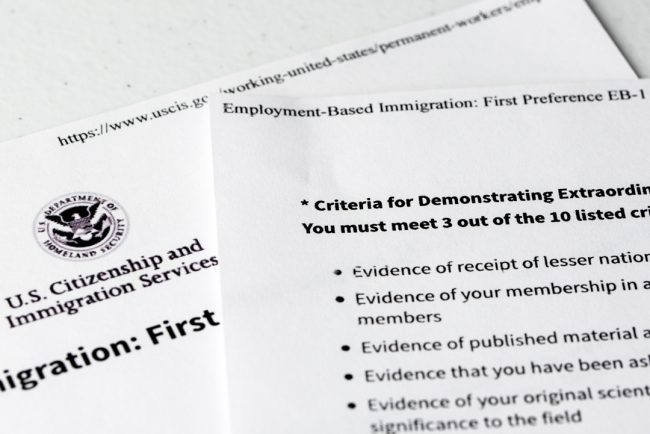A few days ago, I received a question from one of our blog readers:
What is the difference between the EB1 and the EB2 green card?
And also, another one:
Is EB1A the same green card type as EB1-1?
In this blog post, I want to provide a complete overview of employment-based (EB) green cards (EB) and explain what is required in each category.
Note: text in italics is a citation from official resource, i.e. the USCIS website.
EB1 – Priority Workers
The EB1 green card is typically used for distinguished experts and individuals with top achievements, outstanding professors and researchers, and multinational managers.
This green card category is the most difficult to satisfy (requirements are at the highest level), but it is also the fastest. During certain periods of the fiscal year, the EB1 priority date for all countries is “current”. This means that applicants from all countries (including Chinese and Indians) may apply immediately for green cards in the EB1 category. Stay tuned for more information about visa availability in one of the next blog posts.

Another advantage is that EB1 doesn’t involve PERM labor certification, which prolongs processing time significantly. One of the three following subcategories (EB1A) doesn’t even require either sponsorship or a job offer from a U.S. employer.
Note: most official sources refer to this green card category as “EB-1“. However, most people simply put a keyword “EB1” (without dash) to the Google search field. This is the main reason why I use simple “EB1” here, so people can easily find this blog.
The EB1 category is divided into the following three subcategories.
EB1A Extraordinary Ability
You must be able to demonstrate extraordinary ability in the sciences, arts, education, business, or athletics through sustained national or international acclaim. Your achievements must be recognized in your field through extensive documentation.
You must meet at least 3 of 10 criteria listed in this blog post or provide evidence of a one-time achievement (i.e., Pulitzer, Oscar, Olympic Medal).

The Extraordinary Ability green card is the only subcategory within EB1 which doesn’t require an offer of employment. Self-petition is allowed. However, the applicant should demonstrate he or she will continue to work in the field in which he/she has extraordinary ability.
You can find several abbreviations and names of this green card subcategory: EB-1A, EB1A, EB1-1, EB-1 EA, EB1a, Extraordinary Ability Green Card, EB-1 Extraordinary Ability etc. All these names are equivalent.
EB1B Outstanding Professors and Researchers
The EB1B requirements are similar to EB1A, but there are certain additional rules.
You must demonstrate international recognition for your outstanding achievements in a particular academic field. You must have at least 3 years experience in teaching or research in that academic area. You must be entering the United States in order to pursue tenure or tenure track teaching or comparable research position at a university or other institution of higher education.
You must include documentation of at least two of the following criteria:
- Evidence of receipt of major prizes or awards for outstanding achievement
- Evidence of membership in associations that require their members to demonstrate outstanding achievement
- Evidence of published material in professional publications written by others about the alien’s work in the academic field
- Evidence of participation, either on a panel or individually, as a judge of the work of others in the same or allied academic field
- Evidence of original scientific or scholarly research contributions in the field
- Evidence of authorship of scholarly books or articles (in scholarly journals with international circulation) in the field
You must also include an offer of employment from the prospective U.S. employer.
The employer must also meet the following requirements:
- The company must employ at least 3 full-time employees in research positions.
- The company must have received recognition for its research accomplishments.
- The company must demonstrate that it has the ability to pay the offered wage.
Common abbreviations for this subcategory are: EB1B, EB-1B, EB1-OR, EB1-OPR, EB1 Outstanding Researcher or Professor etc.
EB1C Multinational Manager Or Executive
The EB1C green card is intended for transferring a manager from a company abroad to U.S. subsidiary.
The requirements for this green card subcategory are the following:
- You must have been employed outside the United States in the 3 years preceding the petition for at least 1 year by a firm or corporation and you must be seeking to enter the United States to continue service to that firm or organization.
- Your employment must have been outside the United States in a managerial or executive capacity and with the same employer, an affiliate, or a subsidiary of the employer.
- Your petitioning employer must be a U.S. employer.
- Your employer must have been doing business for at least 1 year, as an affiliate, a subsidiary, or as the same corporation or other legal entity that employed you abroad.
Typical abbreviations for this subcategory are EB1-C, EB1C, EB1 MM, EB1 Multinational Manager, etc.
EB2 – Professionals with Advanced Degree / Exceptional Ability, National Interest Waiver
Successful EB2 applicants usually have finished university education (advanced degree) or have a degree of expertise significantly above ordinary peers (exceptional ability).
The requirements aren’t as high as the EB1 category, but processing time is usually longer. In addition, nationals from China and India may not apply for Adjustment of Status (I-485) immediately because visa numbers usually aren’t current. Practically, this means waiting for several years for their green card.
The EB2 petition must be submitted by a U.S. employer – sponsorship is required for all EB2 categories, except for the National Interest Waiver (NIW) subcategory. One of the major disadvantages of the EB2 green card is also PERM labor certification. In this lengthy process, Department of Labor must certify that there are no U.S. workers available for an offered job position. PERM isn’t required for the NIW subcategory.
You might find several names for this category, for example: EB-2 (this is the most accurate abbreviation), EB2, Employment-based green card of Second Preference, etc.
The EB2 green card is divided into the following subcategories.
EB2 Advanced Degree
The job you apply for must require an advanced degree and you must possess such a degree or its equivalent (a baccalaureate degree plus 5 years progressive work experience in the field).
Advanced degree is a master’s degree or a doctorate.
EB2 Exceptional Ability
You must be able to show exceptional ability in the sciences, arts, or business. Exceptional ability “means a degree of expertise significantly above that ordinarily encountered in the sciences, arts, or business.”
You must meet at least three of the criteria below:
- Official academic record showing that you have a degree, diploma, certificate, or similar award from a college, university, school, or other institution of learning relating to your area of exceptional ability
- Letters documenting at least 10 years of full-time experience in your occupation
- A license to practice your profession or certification for your profession or occupation
- Evidence that you have commanded a salary or other remuneration for services that demonstrates your exceptional ability
- Membership in a professional association(s)
- Recognition for your achievements and significant contributions to your industry or field by your peers, government entities, professional or business organizations
- Other comparable evidence of eligibility is also acceptable
EB2 National Interest Waiver
The EB2 National Interest Waiver green card is often filed by researchers and younger scientists in academia who don’t yet qualify for EB1A green card and still need/want to submit via self-petition.
However, National Interest Waiver (abbreviation NIW) is not limited only to researchers. For example, entrepreneurs, exceptional artists or businessmen who demonstrate significant benefits for the United States might successfully apply for the NIW green card.
Successful NIW applicants must meet one of the two requirements mentioned above:
- having an Advanced Degree or
- Exceptional Ability
In addition, you must demonstrate that it is in the national interest that you work permanently in the United States. This last requirement is the most difficult to satisfy. I discuss this in greater detail at my other blog.
Aliens seeking a national interest waiver are requesting that the Labor Certification be waived because it is in the interest of the United States. Though the jobs that qualify for a national interest waiver are not defined by statute, national interest waivers are usually granted to those who have exceptional ability (see above) and whose employment in the United States would greatly benefit the nation.
As briefly referenced above, the NIW green card has two great advantages. Those seeking a national interest waiver may self-petition (they do not need an employer to sponsor them) and may file their labor certification directly with USCIS along with their Form I-140, Petition for Alien Worker. Simply said, you don’t wait for approval of PERM labor certification at Department of Labor which means significantly shorter processing time.
EB3 – Skilled Workers, Professionals and Other Workers
The EB3 green card is intended for workers with the lowest qualification when compared to EB1 and EB2 category.
While eligibility requirements for the third preference classification are less stringent, you should be aware that a long backlog exists for visas in the “other workers” category. This means even over 10 years of waiting for certain nationalities. Check the current Visa Bulletin at Department of State website.
Another disadvantage is that there is no subcategory for self-petition within EB3. All petitions require a permanent, full-time job offer and sponsorship from U.S. employer. The offered job position must not be of a temporary or seasonal nature.
All 3 of the subcategories within EB3 (described immediately below) must also meet this requirement: you must be performing work for which qualified workers are not available in the United States. The PERM labor certification must be approved at the Department of State.
EB3 Skilled Workers
“Skilled workers” are persons whose job requires a minimum of 2 years training or work experience.
EB3-A or EB3A is common abbreviation of this EB3 subcategory.
EB3 Professionals
“Professionals” are persons whose job requires at least a U.S. baccalaureate degree or a foreign equivalent and are a member of the professions.
Education and experience may not be substituted for a baccalaureate degree.
Baccalaureate degree is the normal requirement for entry into the occupation.
This subcategory is referred as EB3-B or EB3B.
EB3 Unskilled Workers (Other Workers)
The “other workers” subcategory is for persons performing unskilled labor requiring less than 2 years training or experience.
Common abbreviations of this subcategory are EB-3C or EB3C.
EB4 Special Immigrants and EB5 Investors
To make this overview complete I briefly mention other two categories of Employment-based green cards:
- EB4 for Religious Workers and other Special Immigrants
- EB5 for Investors who make the necessary investment in a commercial enterprise in the United States and plan to create or preserve 10 permanent full-time jobs for qualified U.S. workers
I hope this post provides a clear explanation of the main differences between EB1, EB2 and EB3 green cards. Please let me know in the comments below if you have any questions.
In the next post, I am going to return solely to EB1A. I plan to write a detailed blog post about an important EB1A precedent case, “Kazarian“, which creates the core of the EB1A green card category.
Je suis étudiant j ai cherché la université jusqu’à présent alors je vous demande de m’aide si c’est possible